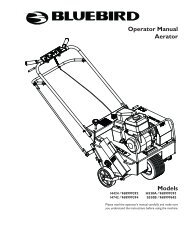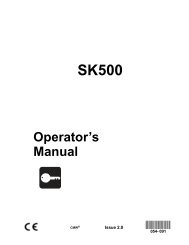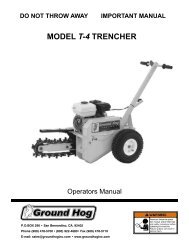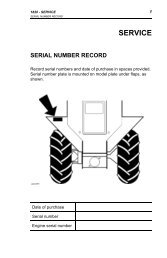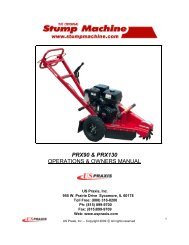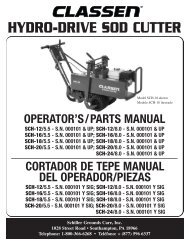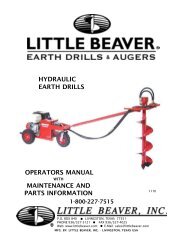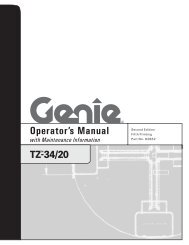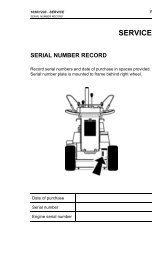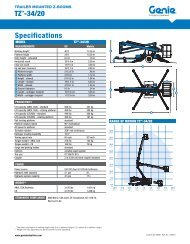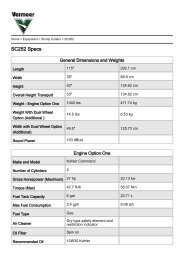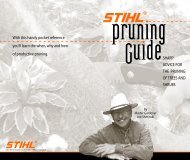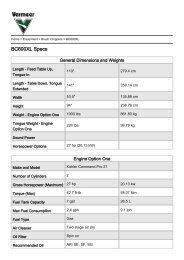How to Thatch, Aerate, and Overseed Your Lawn - Taylor Rental ...
How to Thatch, Aerate, and Overseed Your Lawn - Taylor Rental ...
How to Thatch, Aerate, and Overseed Your Lawn - Taylor Rental ...
Create successful ePaper yourself
Turn your PDF publications into a flip-book with our unique Google optimized e-Paper software.
ABREATHOFFRESHAIR.<br />
BLUEBIRD’S AERATORS OFFER THE HIGHEST PRODUCTIVITY WITHOUT DAMAGING THE TURF.<br />
▲<br />
742 LAWN AERATOR<br />
AERATION<br />
Soil compaction is a frequent cause of turf deterioration. Caused by<br />
lawn traffic such as walking <strong>and</strong> mowing, compaction is greatest in the<br />
<strong>to</strong>p 2-3" of the soil. In compacted soil, dirt particles are forced <strong>to</strong>gether<br />
reducing the area where roots can grow. Aeration, the process of<br />
mechanically removing cores of turf, relieves compacted soil by<br />
improving the exchange of water <strong>and</strong> critical nutrients between the<br />
atmosphere <strong>and</strong> the grass’ roots.<br />
For optimal effectiveness, aeration should be performed at least once<br />
annually. Spring (between March <strong>and</strong> May) <strong>and</strong>/or fall (between August<br />
<strong>and</strong> November) are the ideal times <strong>to</strong> aerate cool-season grasses, such<br />
as perennial ryegrass <strong>and</strong> Kentucky bluegrass. Warm season grasses,<br />
such as zoysiagrass <strong>and</strong> bermudagrass benefit the most from spring <strong>and</strong><br />
summer aeration. In drier climates aeration increases drought resistance<br />
while decreasing the amount of watering necessary <strong>to</strong> help lawns remain<br />
healthy.<br />
<strong>Lawn</strong>s that receive regular aeration will be greener, easier <strong>to</strong> maintain<br />
<strong>and</strong> suffer from fewer pest problems <strong>and</strong> disease.<br />
▲<br />
Evenly spaced cores of turf up <strong>to</strong> 3” in depth.<br />
ACHIEVING THE BEST RESULTS.<br />
• Water area <strong>to</strong> be aerated the night before. This will help <strong>to</strong> soften the<br />
soil allowing for maximum core penetration.<br />
• Before beginning, map out any obstructions such as sprinkler heads<br />
or drains.<br />
• Cover every inch of the lawn <strong>and</strong> go over high traffic areas more<br />
than once.<br />
• After aerating, water the lawn <strong>and</strong> apply fertilizer. This will promote<br />
growth <strong>and</strong> allow grass <strong>to</strong> compete with weeds as they grow.<br />
1<br />
2<br />
3<br />
4<br />
1 2 3 4<br />
Adequate amounts of vital turf nutrients including water, oxygen,<br />
nitrates, phosphorus, <strong>and</strong> potassium are unable <strong>to</strong> reach the roots.<br />
Aera<strong>to</strong>rs relieve soil compaction by removing evenly-spaced cores<br />
of turf up <strong>to</strong> 3" in depth.<br />
Once the soil is aerated air exchange is improved <strong>and</strong> the soil can<br />
easily absorb water, fertilizer <strong>and</strong> other nutrients.<br />
Aeration promotes deeper root growth for a lawn that is lush,<br />
healthy <strong>and</strong> drought resistant.<br />
GUIDE<br />
TO<br />
LAWN<br />
CARE<br />
TURF MANAGEMENT TIPS FROM BLUEBIRD EXPERTS<br />
© 2005 BlueBird International. All rights reserved.
THE ULTIMATE COMBO.<br />
BLUEBIRD’S POWER RAKES AND SEEDERS WORK BEST TOGETHER TO ACHIEVE ULTIMATE RESULTS.<br />
PR22 POWER RAKE<br />
DETHATCHING<br />
If your lawn is dull, yellowing <strong>and</strong> lifeless it may be due <strong>to</strong> an excessive<br />
amount of thatch. <strong>Thatch</strong> is a layer of dead stems, roots <strong>and</strong> clippings<br />
between the soil’s surface <strong>and</strong> the green vegetation, which can deprive your<br />
lawn of vital nutrients. A thatch layer of one-half inch or more also prohibits<br />
water <strong>and</strong> air from entering the grass roots <strong>and</strong> provides the perfect<br />
breeding environment for insects <strong>and</strong> disease. A simple process called<br />
dethatching provides the best solution <strong>to</strong> thatch build-up <strong>and</strong> can res<strong>to</strong>re<br />
an unhealthy yellowing lawn.<br />
Dethatching is a process that mechanically removes accumulated thatch<br />
using steel flail blades or rigid wire tines <strong>to</strong> lift thatch debris <strong>to</strong> the surface<br />
for removal. Once this build up is eliminated, air, water <strong>and</strong> nutrients can<br />
flow freely <strong>to</strong> the roots, rejuvenating a yellowing lifeless lawn.<br />
Dethatching may cause some minor damage <strong>to</strong> the turf, or browning for<br />
a short period after using a lawn comber. To expedite the recovery of the<br />
lawn, all thatch should be removed. Fertilizer <strong>and</strong> herbicide should then be<br />
applied <strong>to</strong> prevent the growth of weeds while replenishing vital nutrients<br />
that the lawn needs <strong>to</strong> regain its green, lush appearance.<br />
1<br />
2<br />
3<br />
4<br />
1 2 3 4<br />
<strong>Thatch</strong> is a dense mat of roots, stems <strong>and</strong> grass clippings that<br />
accumulates between the soil <strong>and</strong> growing blades of grass.<br />
Combing with flail blades, delta reel blades or spring tines will<br />
effectively remove thatch buildup.<br />
With thatch removed, air, water, nutrients, herbicides <strong>and</strong><br />
pesticides can do their job. Turf becomes healthier <strong>and</strong> more<br />
resistant <strong>to</strong> insect damage <strong>and</strong> disease.<br />
Dethatching at regular intervals promotes denser growth <strong>and</strong><br />
ensures you’ll have a vibrant lawn.<br />
OVERSEEDING FOR BETTER TURF<br />
For best results, we recommend overseeding in two applications, with<br />
the second application made at a 45-degree angle <strong>to</strong> the first. You’ll notice<br />
a distinct crosshatch pattern in the effected soil as the BlueBird delta<br />
blade reel cuts precisely aligned rows allowing the seed <strong>to</strong> penetrate in<strong>to</strong><br />
the <strong>to</strong>psoil.<br />
SEEDER<br />
OVERSEEDING<br />
<strong>Lawn</strong>s suffering from thin, bare patches or those without any grass<br />
at all require aggressive renovation techniques. The lawn may be revived<br />
by overseeding with a lawn seeder.<br />
The hopper drops a measured amount of seed in<strong>to</strong> the soil prepared<br />
by the action of the rotating knife blades. As the lawn seeder moves<br />
forward, the neoprene flap smoothes the soil <strong>to</strong> cover the seed <strong>and</strong> aids<br />
germination.<br />
Water thoroughly as soon as overseeding is complete <strong>and</strong> lightly each<br />
day until the seed germinates. Once the grass has sprouted, water<br />
regularly <strong>to</strong> encourage deeper growth.<br />
View our full line at www.bluebirdintl.com.<br />
FOR MORE INFORMATION, VISIT YOUR LOCAL BLUEBIRD DEALER, RENTAL COMPANY OR CONTACT BLUEBIRD AT 800-808-BIRD OR FAX 800-254-BIRD.



